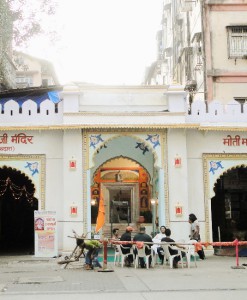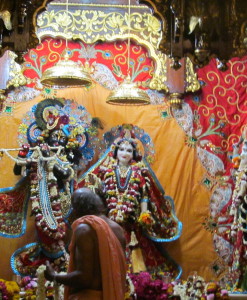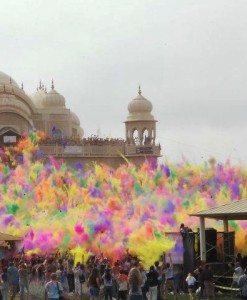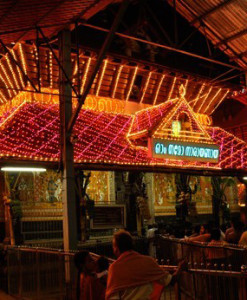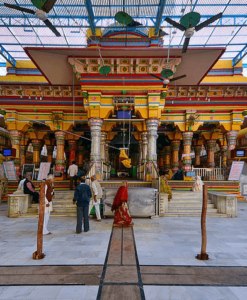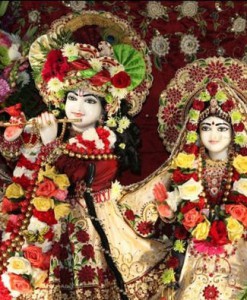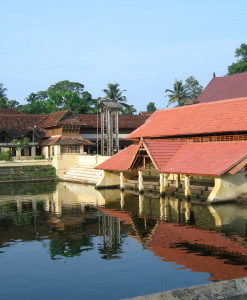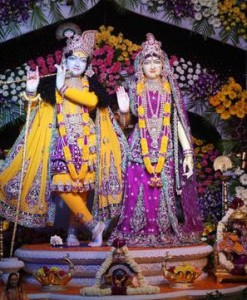No products in the cart.
The self manifested deity out of the Saligram Shila, over 500 years old heritage temple where standards of worship are highest in Vrindavan. Radha Raman Temple was established by Gopal Bhatta Goswami. He is one of the six Goswamis of Vrindavan who followed the principles of Sri Chaitanya Mahaprabhu strictly. This beautiful Deity is self-manifested from a saligram sila and has a mystic smile on his face.
Sri Radha Raman’s Appearance Place is in the Radha-Raman Temple, next to the samadhi of Gopala Bhatta. Gopala Bhatta Goswami erected this temple. The deity was installed on the full moon day in the month of Vaishaka (April-May) in the year 1542. This event is celebrated every year by bathing the deity with milk and various other items. Gopala Bhatta Gosvami’s other shalagram-shilas are also worshiped in the temple. The samadhi of Gopala Bhatta is located next to Raman’s appearance place in Radha-Raman Temple.
Sri Radha Raman Temple, Vrindavan;
After Sri Caitanya Mahaprabhu’s disappearance Gopala Bhatta Gosvami felt intense separation from the Lord. To relieve his devotee, the Lord instructed Gopala Bhatta in a dream :”If you want my darsan then make a trip to Nepal”.
In Nepal, Gopala Bhatta bathed in the famous Kali-Gandaki River. Upon dipping his waterpot in the river, he was surprised to see several Shaligrama Shilas enter his pot. He dropped the shilas back into the river, but the shilas re-entered his pot when he refilled it.
After emptying and refilling his waterpot for the third time, Gopala Bhatta Gosvami found twelve Shaligrama shilas sitting there. Thinking this must be the Lords mercy, he kept all the shilas and returned to Vrndavana.
Sri Gopala Bhatta Gosvami used to worship twelve Shaligram silas. Wherever he would go he would bring them with him in a piece of cloth tied at the corner. One day a wealthy man (Seth) came to Vrndavana and offered Gopala Bhatta a variety of clothing and ornaments for his Shaligrams.
Being very impressed with the Gosvami he wanted his darshan and to render some service which he presented in the form of some valuable cloths and ornaments. However, Gopala Bhatta couldn’t use these for his round-shaped Shaligrams, so he advised the donor to give the Deity decorations to someone else, but the Seth insisted. Gopala Bhatta kept the cloths and ornaments with his shilas. While Gopala Bhatta Gosvami was absorbed in remembering how the half-man, half-lion form of the Supreme Lord had manifested from the pillar in Hiranyakasipu’s palace, he prayed in transcendental lamentation to the Lord:
“Oh my Lord, you are very merciful and always fulfill the desires of your devotees. I wish to serve you in your form, having arms and legs and blissful smiling face, with lotus eyes…. If I had a Deity then I would be able to decorate Him so nicely with these clothes and ornaments.”
In the evening after offering some bhoga and arotika to his Shalagram shilas, Gopala Bhatta put them to rest, covering them with a wicker basket. Late in the night, Gopala Bhatta took a little rest and then, in the early morning went to take bath in the Yamuna river. Returning from his bath, he uncovered the Shalagramas in order to render the puja for Them, and saw amongst Them a Deity of Krishna playing the flute. There were now eleven shilas and this Deity. The “Damodara shila”, had manifested as the beautiful three-fold bending form of tri-bhangananda-krishna. Floating in the ocean of ecstasy, he fell to the ground in order to offer his dandavats and then recited various prayers and hymns. This wonderful event of the appearance day of Radha-raman happened on the day after Sri Nrisimha Chaturdasi, and is celebrated on that day accordingly. That day they offer 500 liters of milk for the Lord’s pleasure and many other sweets and different things. The Radha-raman temple has the highest standard of Deity worship in all of Vraj.
When Rupa and Sanatana Gosvamis as well as many other devotees received news of this miraculous event they came running to see the Lord. Gazing on the Lord’s transcendental form, which bewildered all the living entities of the many various planets, they all bathed Him with their tears. This Deity whom the Gosvamis named, “Sri Radha-raman Deva” made His appearance on the full moon day of Vaisakha in the year 1542. Except for Vrindadevi, Sri Radha-Ramanaji is the only one of the original Deities of Vrindavana who never left to go to Jaipur. Sri Sri Radha-raman-ji is still being worshipped in Vrindavana near Nidhuban kunj in the compound of the temple.
The Deity is called Radha-raman although physically there is no apparent Deity of Radha there. As one can see from the picture at the top of this page, that to the right of the picture (to Ramanji’s left) is a place setting for Srimati Radhika. In this way the pujaris worship Sri Radha and Ramanji together.
Sri Radha-ramana Deva, unlike other Deities, has very intricate features, including fingernails and even teeth. On the back side of His body parts of the original Shalagram shila from which He manifested Himself can be seen.
Gopala Bhatta Gosvami established this temple. The Deity of Sri Radha-Raman was manifested from one of Gopala Bhatta Gosvami’s shalagram-shilas (Damodara), on the full moon day (Purnima), 15th day of the month of Vaishaka (April-May) in 1542. It is the day after the appearance day of Lord Narasimha.
Sri Radha Raman’s Appearance Place is in the Radha-Raman Temple, next to the samadhi of Gopala Bhatta. It is said that there are markings of discs on the Deity’s back and feet.The Deity of Radha-Raman is around 30cm (1 foot) tall. Gopala Bhatta Gosvami’s other shalagram-shilas are also worshiped on the altar here. Radha-Ramanji is one of the few original Deities of the Gosvamis still in Vrindavana.
The standard of worship in this temple is very high. There is no Deity of Radha in this temple. The name of Radharani is worshiped in this temple, because according to scriptures the name and the person are considered non-different. There is a golden plate next to Krishna, which has the name of Radharani engraved into it.
A Deity of Radharani is not worshiped in this temple because the Deity of Radha-Raman is self-manifested and there was no Deity of Radharani self-manifested. Sri Chaitanya Mahaprabhu’s kaupina (cloth) and asana (seat), which Gopala Bhatta Gosvami brought from Jagannath Puri, are also in this temple. The asana is black wood and is about 31cm (12″) by 25cm (10″). They are brought out to be seen by the public for six days a year.
By Road: There are many ways to reach Vrindavan by road. Vrindavan is 11 Kms from Mathura, 57 Kms from Hathras, 70 Kms from Aligarh, 73 Kms from Agra, 139 Kms from Gurgaon and 144 Kms from New Delhi. Vrindavan is well connected with other states and cities like Rajasthan, Haryana, Ghaziabad, Lucknow and Uttaranchal through Uttar Pradesh State Road Transport Corporation (UPSRTC) and some private travel services. There are no bus routes from other major cities to Vrindavan. Nearest bus stand is Mathura.
By Rail: It has its own Railway Station named as Vrindavan Railway Station which is connected to almost all the major cities of Uttar Pradesh like Delhi, Jaipur, Nagpur, Pune and Bangalore.
By Air: The nearest International Airport from Vrindavan is Indira Gandhi International Airport, New Delhi, about 144 Kms away and is roughly four hour drive from Vrindavan city. Frequent Flights to various national and international destinations such as Hyderabad, Ahmedabad, Aurangabad, Bangalore, Bhopal, Chennai, and Coimbatore take off from here.
This temple Opening & Closing times is 4.00 AM and 8.00 PM. During this period major part of the Lord Krishna rituals are performed. Archana, Aarti and Abhisekham are the daily pujas performed.
Mangala Arati – 4:00am
Darshan – 08:00am – 12:30pm
Evening Darshan: – 6pm – 8pm (18:00 – 20:00 hrs)
Winter – Temple Timings
Mangala Arati – 05:30am
Darshan – 08:00am – 12:30pm
Evening – 6pm – 8pm (18:00 – 20:00 hrs)
Festivals Celebrated here are:
• Rama Navami
• Chandan Yatra
• Jhulan Yatra
• Balaram Purnima
• Sri Krishna Janmashtami
• Radhashtami
• Kartika
• Nityananda Trayodasi
• Vasant Pancami
• Gaura Purnima



